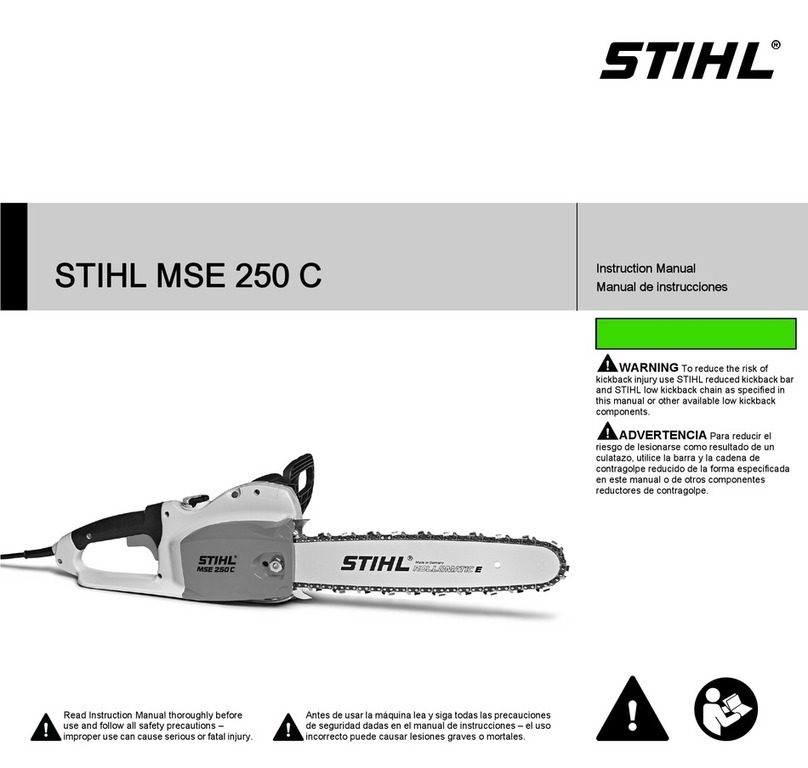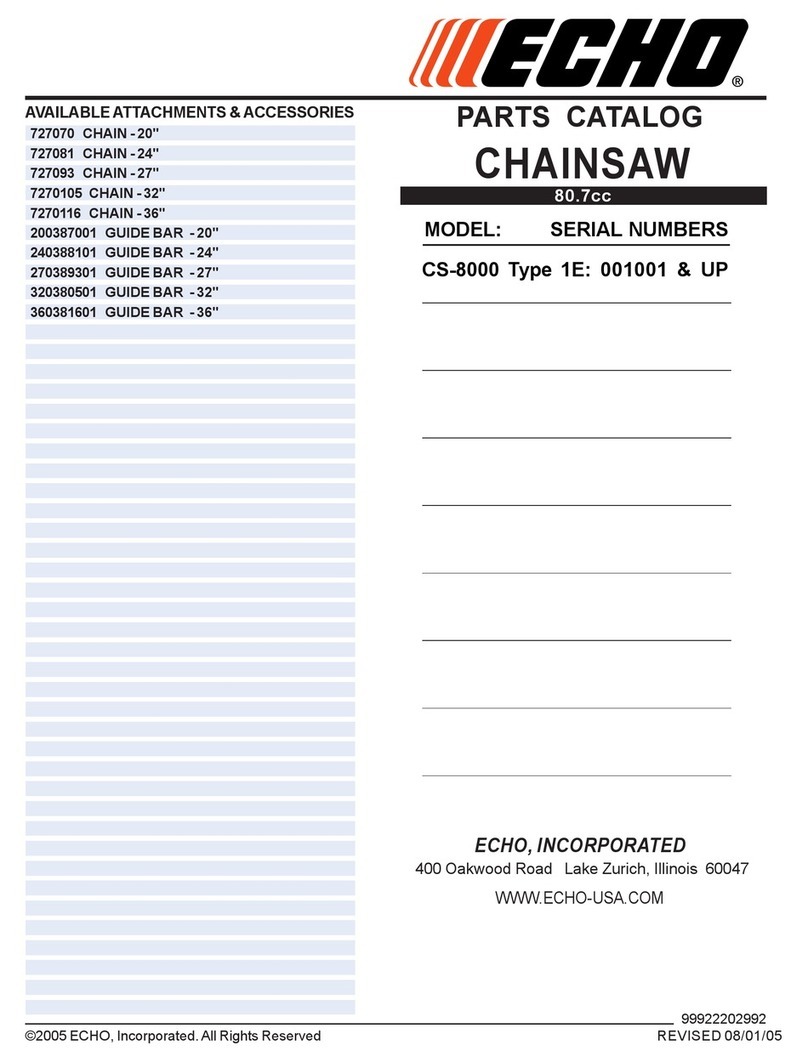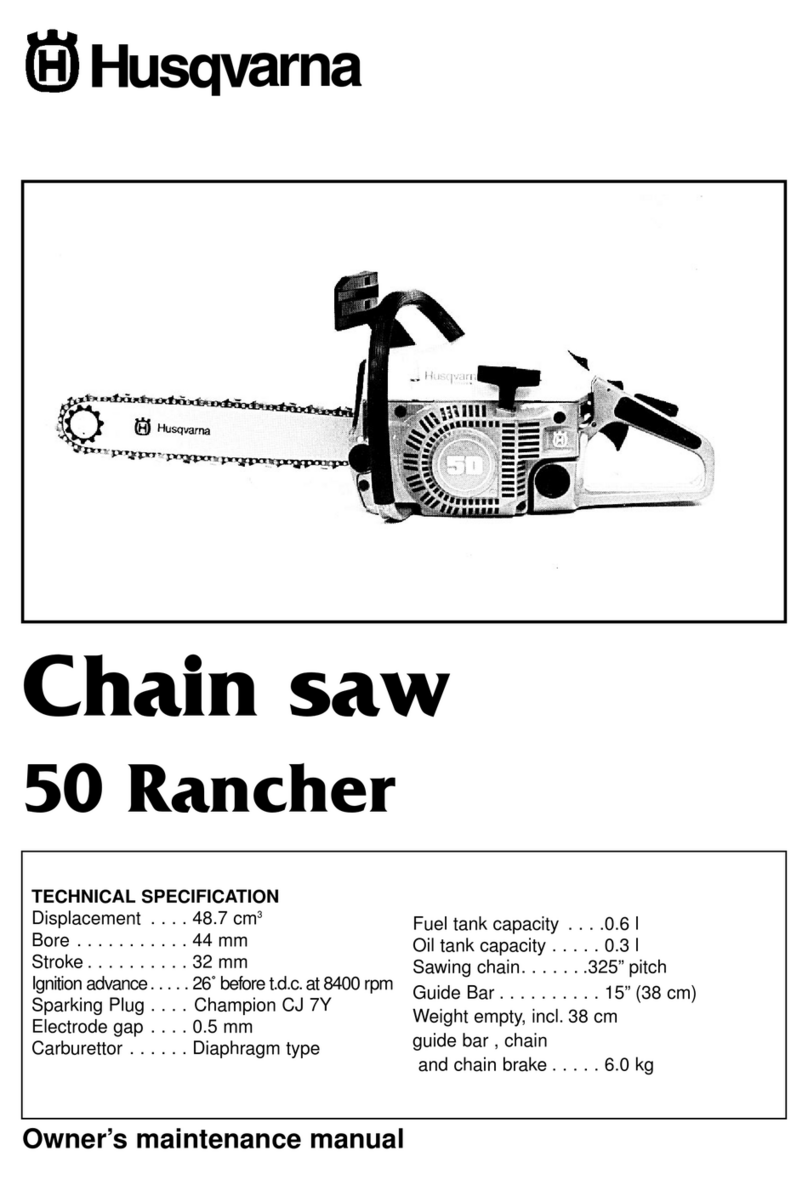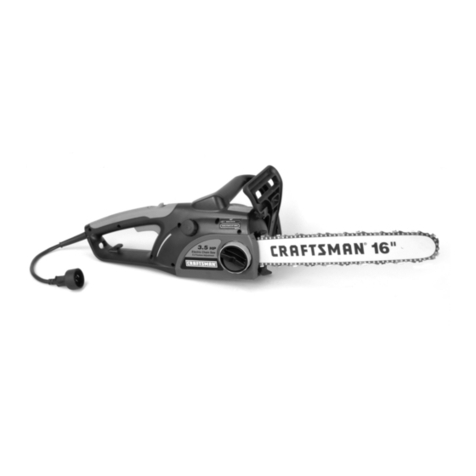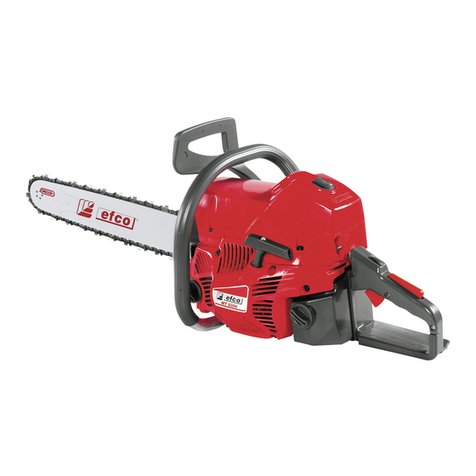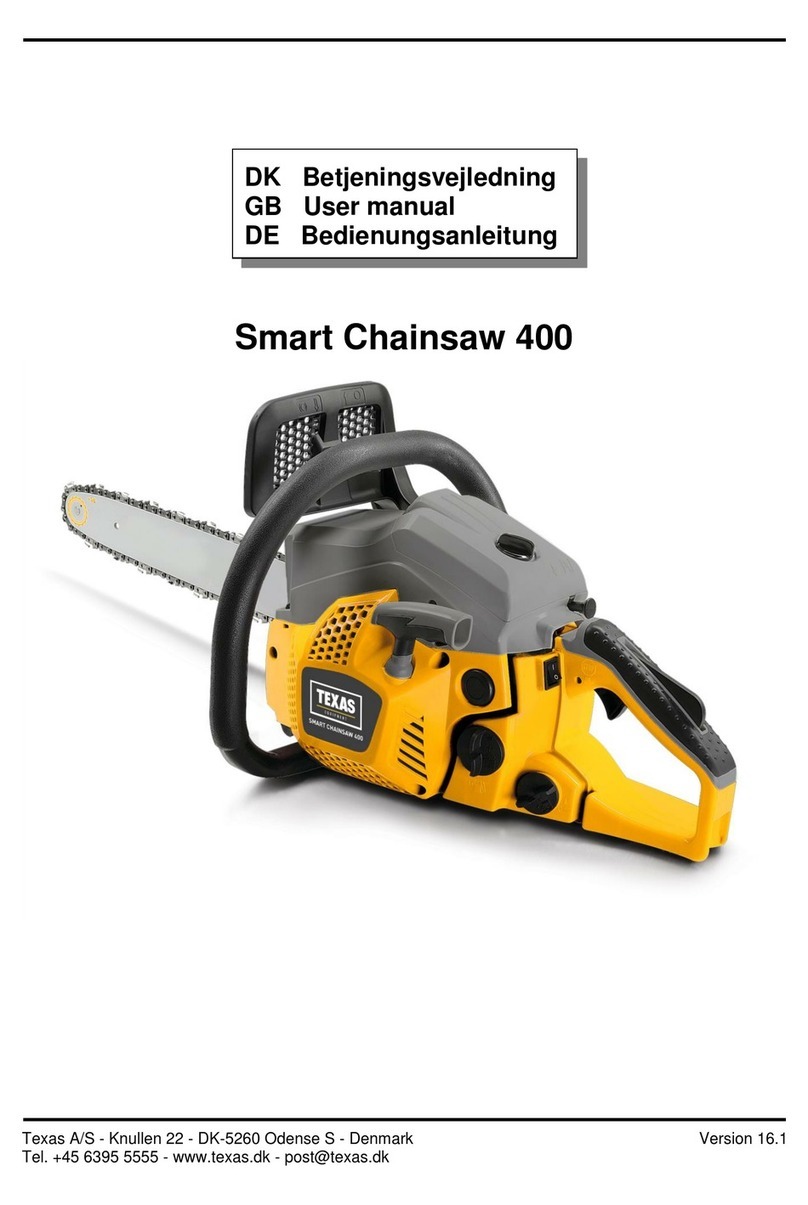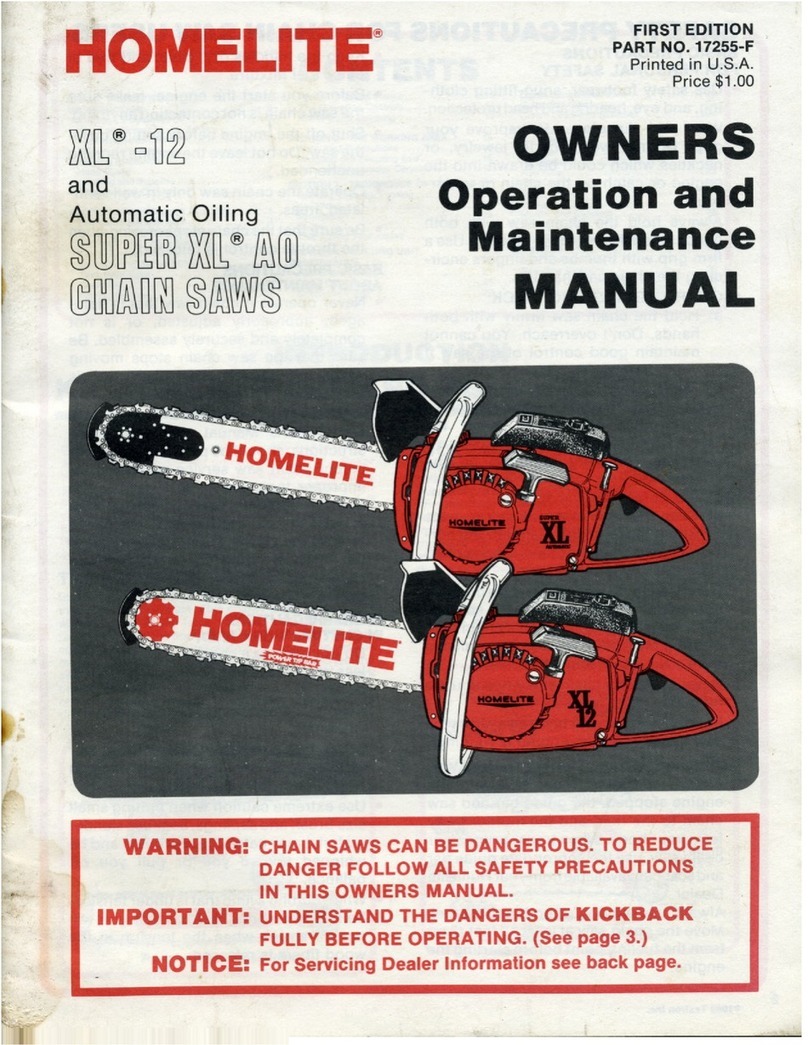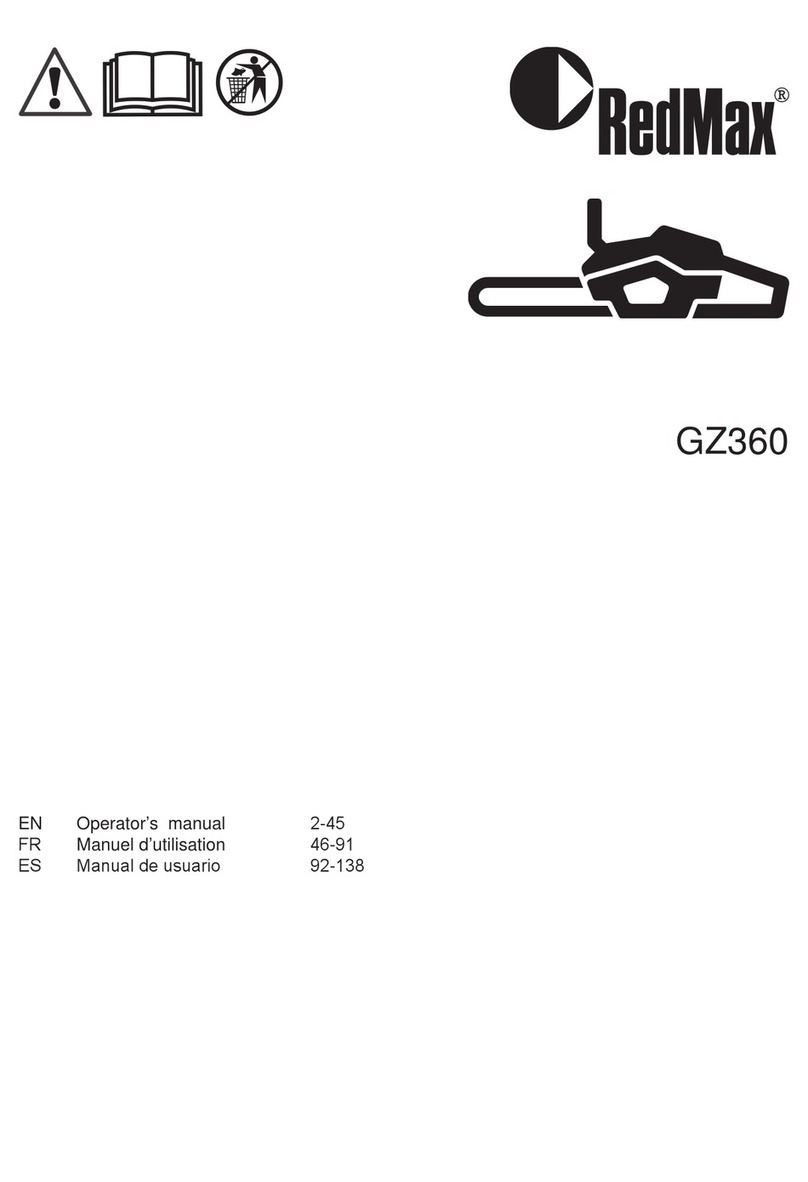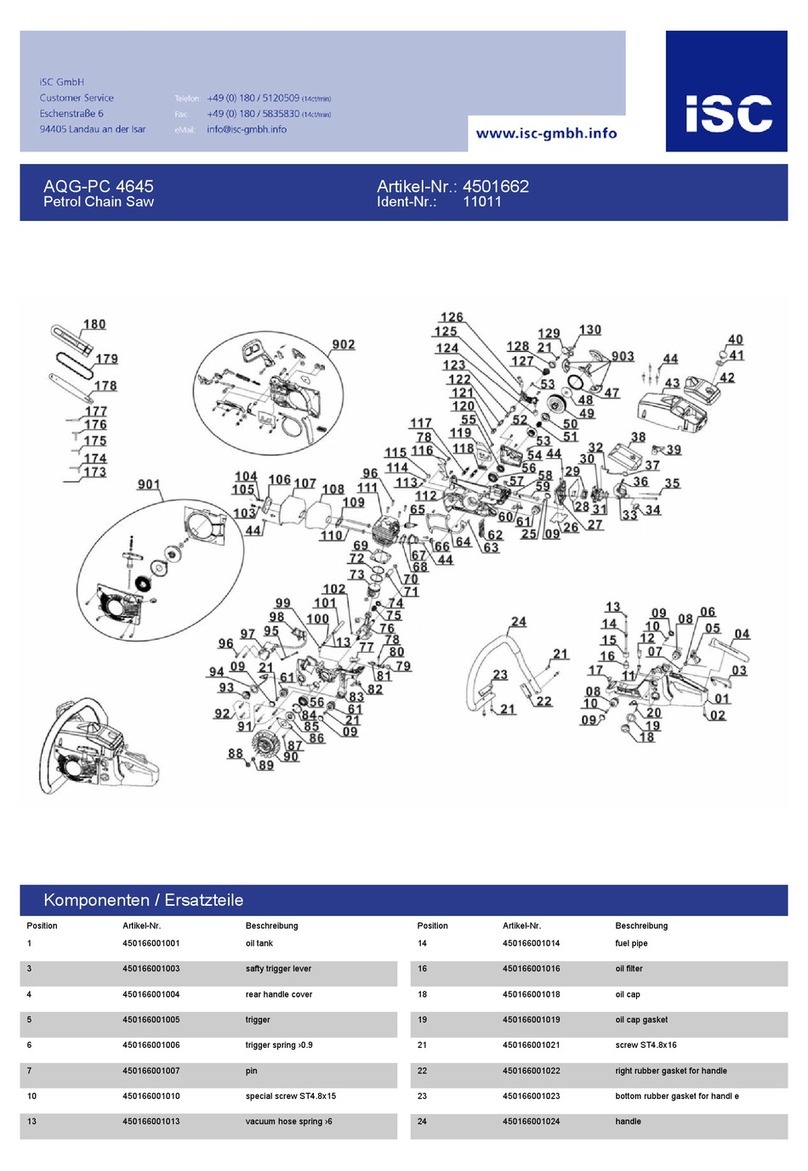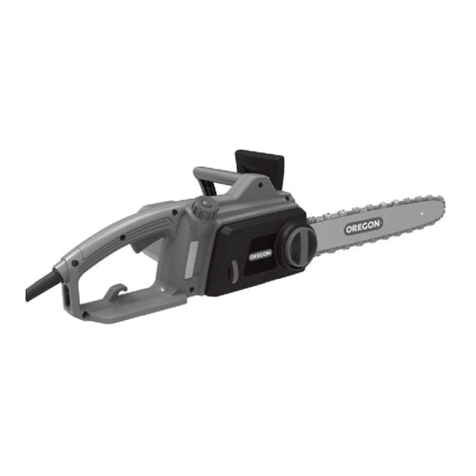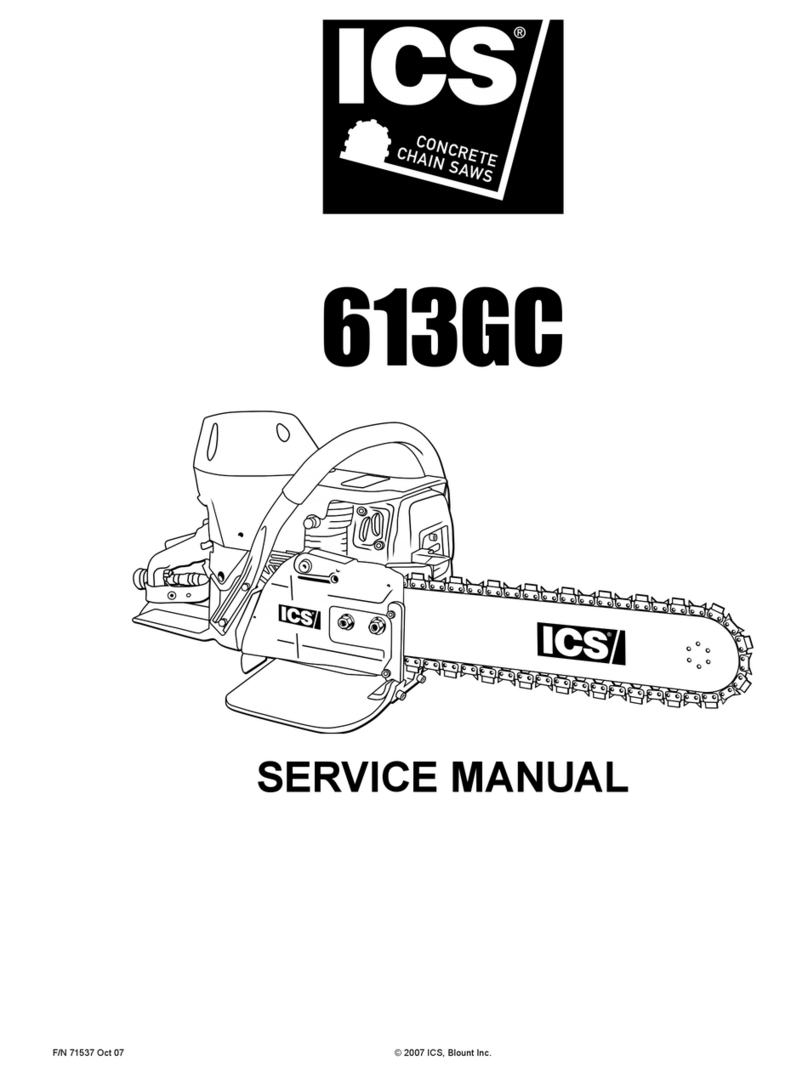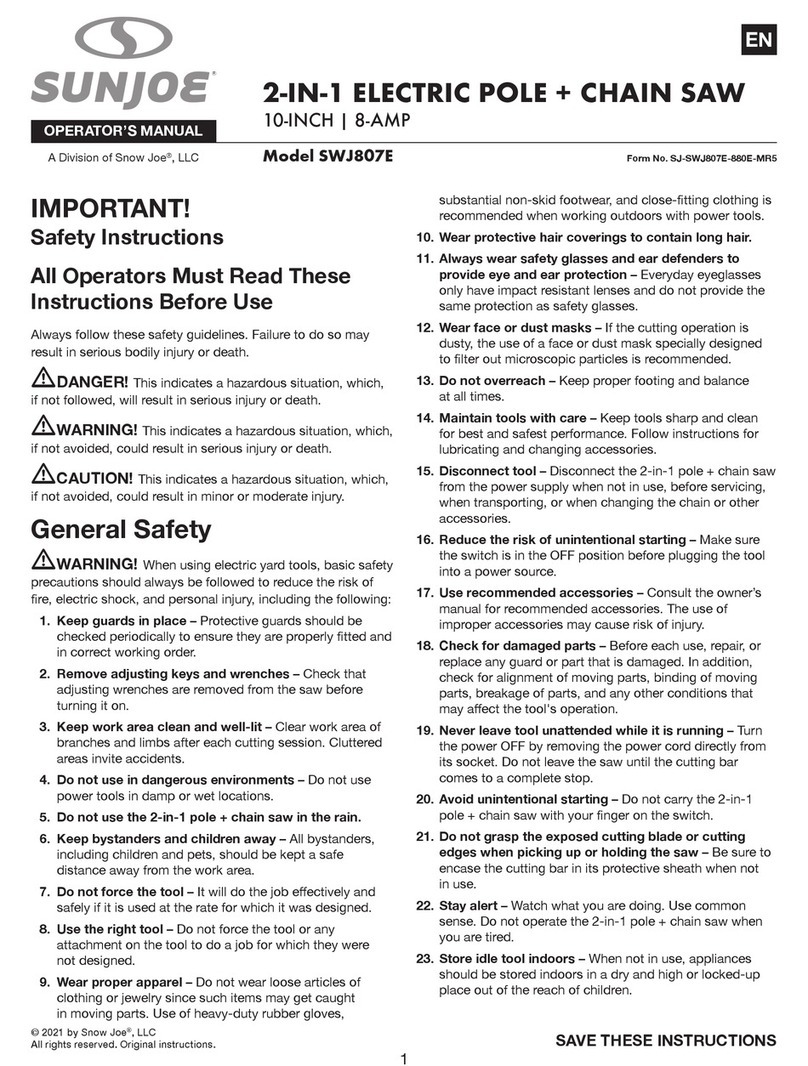Bavaria 45.016.36 User manual

Art.-Nr.: 45.016.36 I.-Nr.: 11013
Original operating instructions
Petrol Chainsaw
BPC 1235/1
Anleitung_BPC_1235_1_SPK7__ 06.05.13 08:58 Seite 1

2
Read and follow the operating instructions and safety information
before using for the first time.
Anleitung_BPC_1235_1_SPK7__ 06.05.13 08:58 Seite 2

3
2
10
6
7
11
14
1
9
19 20
4
318 16
13
17
15
12
8
1
2
B
A
F
G
3A
3D
3B
5
E
3C
D
Anleitung_BPC_1235_1_SPK7__ 06.05.13 08:58 Seite 3

4
A
D
B
C
4A 4B
BCA
6
7A
8
7B
9A
B
A
C
A
IA
0
5
D
Anleitung_BPC_1235_1_SPK7__ 06.05.13 08:58 Seite 4

5
10 11
A
B
9B 9D
B
D
A
B
C
9E
9C
C
13 1412
AB
Anleitung_BPC_1235_1_SPK7__ 06.05.13 08:58 Seite 5

6
16A 16B15
17 18A16C
1918B
21A 21B
20
A
A
B
C
A
B
D
CA
Anleitung_BPC_1235_1_SPK7__ 06.05.13 08:58 Seite 6

7
2423 25
26
22
A
Anleitung_BPC_1235_1_SPK7__ 06.05.13 08:58 Seite 7

8
GB
Table of contents:
1. Safety regulations
2. Layout
3. Intended use
4. Technical data
5. Before starting the equipment
6. Operation
7. Cleaning, maintenance, storage and ordering of spare parts
8. Disposal and recycling
9. Troubleshooting guide
Anleitung_BPC_1235_1_SPK7__ 06.05.13 08:58 Seite 19

Important!
When using equipment, a few safety precautions
must be observed to avoid injuries and damage.
Please read the complete operating manual with due
care. Keep this manual in a safe place, so that the
information is available at all times. If you give the
equipment to any other person, give them these
operating instructions as well.
We accept no liability for damage or accidents which
arise due to non-observance of these instructions
and the safety information.
1. Safety information
Please refer to the booklet included in delivery for the
safety instructions.
CAUTION!
Read all safety regulations and instructions.
Any errors made in following the safety regulations
and instructions may result in an electric shock, fire
and/or serious injury.
Keep all safety regulations and instructions in a
safe place for future use.
2. Layout (Fig. 1)
1. Chain bar
2. Saw chain
3. Chain tensioning screw
4. Stop claw
5. Chain brake lever / front hand guard
6. Front handle
7. Starter handle
8. Spark plug (under the air filter cover)
9. Air filter cover
10. Stop switch
11. Safety lock
12. Oil tank cap
13. Fan housing
14. Fuel tank cap
15. Rear handle / bootstrap
16. Chain guard
17. Choke / (carburetor setting)
18. Bar fastening nut
19. Throttle lever
20. Chain catch
Safety features (fig.1)
2LOW KICKBACK SAW CHAIN helps significantly
reduce kickback, or the intensity of kickback, due
to specially designed depth gauges and guard
links.
5CHAIN BRAKE LEVER / HAND GUARD protects
the operator’s left hand in the event it slips off the
front handle while saw is running.
5CHAIN BRAKE is a safety feature designed to
reduce the possibility of injury due to kickback by
stopping a moving saw chain in milliseconds. It is
activated by the CHAIN BRAKE lever.
10 STOP SWITCH immediately stops the engine
when tripped. Stop switch must be pushed to ON
position to start or restart engine.
11 SAFETY TRIGGER prevents accidental
acceleration of the engine.Throttle trigger (19)
cannot be squeezed unless the safety latch is
depressed.
20 CHAIN CATCHER reduces the danger of injury in
the event saw chain breaks or derails during
operation. The chain catcher is designed to
intercept a whipping chain.
Note: Study your saw and be familiar with its parts.
3. Proper use
The chainsaw is designed exclusively for sawing wood.
You may only fell trees if you have received the
appropriate training. The manufacturer cannot be held
liable for damage caused by improper or incorrect
usage.
The machine is to be used only for its prescribed
purpose. Any other use is deemed to be a case of
misuse. The user / operator and not the
manufacturer will be liable for any damage or injuries
of any kind caused as a result of this.
Please note that our equipment has not been
designed for use in commercial, trade or industrial
applications. Our warranty will be voided if the
machine is used in commercial, trade or industrial
businesses or for equivalent purposes.
9
GB
Anleitung_BPC_1235_1_SPK7__ 06.05.13 08:58 Seite 20

4. Technical data
mc2.73tnemecalpsidenignE 3
Maximum engine capacity 1.2 kW
mc23Max. cutting length
)mc53(”41htgnelliarrettuC
mm525,9,)”8/3(hctipniahC
Chain thickness (0.05”), 1.27 mm
Idling speed 3100 ± 300 rpm
Maximum speed with cutting equipment 11000 rpm
s/m12.xamdeepsniahC
mc013yticapacknaT 3
mc012yticapacknatliO 3
seYnoitcnufnoitarbiv-itnA
Chain wheel teeth 6 teeth x 9.525 mm
seYekarbniahC
seYhctulC
Automatic chain lubrication Yes
seYniahckcabkcik-woL
Net weight without chain and chain bar 4.5 kg
gk5)yrd(thgiewteN
Fuel consumption (specific) 560 g / kWh
LPA sound pressure level (ISO 22868) 100 dB(A)
)A(Bd5.2ytniatrecnuAPK
LWA sound power level measured
)A(Bd9.011)86822OSI(
)A(Bd5.2ytniatrecnuAWK
LWA sound power level guaranteed
)A(Bd211)CE/41/0002OSI(
Ahv vibration (front handle)
s/m64.5.xam)76822OSI( 2
s/m5.1ytniatrecnuvhK 2
Ahv vibration (rear handle)
s/m12.6.xam)76822OSI( 2
s/m5.1ytniatrecnuvhK 2
Chain type Kangxin 91S053T
Bar type Kangxin P014-50SR
FTR8LgulpkrapS
Keep the noise emissions and vibrations to a
minimum.
Only use appliances which are in perfect working
order.
Service and clean the appliance regularly.
Adapt your working style to suit the appliance.
Do not overload the appliance.
Have the appliance serviced whenever
necessary.
Switch the appliance off when it is not in use.
Wear protective gloves.
5. Before starting the equipment
Important: Do not start the engine until the saw
is fully assembled.
Important: Wear protective gloves at all times
when handling the chain.
5.1 Fit the chain bar
To ensure that the bar and the chain are supplied
with oil, USE ONLY THE ORIGINAL BAR. The oiling
hole (Fig. 2/Item A) must be kept clear of dirt and any
build-up of residue.
1. Make sure the Chain brake lever is pulled back
into the DISENGAGED position (Fig. 3A)
2. Remove the two bar fastening nuts (B). Remove
the cover (Fig. 3B).
3. Using a screwdriver, run the adjustment screw (D)
COUNTERCLOCKWISE until the TANG (E)
(projecting prong) is to the end of its travel toward
the clutch drum and sprocket (Fig. 3B/3C).
4. Fit the open end of the chain bar over the die bar
pins (F) (Fig. 3C/3D).
5.2 To install saw chain
1. Spread chain out in a loop with cutting edges (A)
pointing CLOCKWISE around loop (Fig. 4A).
2. Slip the chain around the sprocket (B) behind the
clutch (C). Make sure the links fit between the
sprocket teeth (Fig. 4B).
3. Guide the drive links into the groove (D) and
around the end of the bar (Fig. 4B).
NOTE: The saw chain may droop slightly on the lower
part of bar. This is normal.
4. Pull the chain bar forward until the chain is closely
seated. Make sure that all the drive links are in the
groove of the bar.
5. Fit the clutch cover and fasten it with 2 screws.
Make sure that the pivot (Fig. 3C/Item E) fits into
the chain bar (Fig. 3D/Item G). The chain must
10
GB
Anleitung_BPC_1235_1_SPK7__ 06.05.13 08:58 Seite 21

not slip off the bar when you do this. Tighten the
two nuts by hand and then follow the instructions
for adjusting the tension in ADJUSTING THE
CHAIN TENSION.
5.3 Saw chain tension adjustment
Proper tension of saw chain is extremely important
and must be checked before starting, as well as
during any cutting operation.
Taking the time to make needed adjustments to the
saw chain will result in improved cutting performance
and prolonged chain life.
Warning: Always wear heavy duty gloves when
handling saw chain or making saw chain adjustments.
1. Hold nose of guide bar up and turn adjustment
screw (D) CLOCKWISE to increase chain
tension. Turning screw COUNTERCLOCKWISE
will decrease amount of tension on chain. Ensure
the chain fits snugly all the way around the guide
bar (Fig. 5).
2. After making adjustment, and while still holding
nose of bar in the uppermost position, tighten the
bar retaining nuts securely. Chain has proper
tension when it has a snug fit all around and can
be pulled around by gloved hand.
NOTE: If chain is difficult to rotate on guide bar or if it
binds, too much tension has been applied. This
requires minor adjustment as follows:
A. Loosen the bar retaining nut so they are finger
tight. Decrease tension by turning the bar
adjustment screw COUNTERCLOCKWISE
slowly. Move chain back and forth on bar.
Continue to adjust until chain rotates freely, but
fits snugly. Increase tension by turning bar
adjustment screw CLOCKWISE.
B. When saw chain has proper tension, hold nose of
bar in the uppermost position and tighten the bar
retaining nut securely.
Caution: A new saw chain stretches, requiring
adjustment after as few as 5 cuts. This is normal with
a new chain, and the interval between future
adjustments will lengthen quickly.
Caution: If the saw chain is TOO LOOSE or TOO
TAUT, the drive wheel, chain bar, chain and crank
shaft bearing will suffer premature wear. Fig. 6 shows
the correct tension A (when cold) and tension B
(when warm). Fig. C shows a chain that is too loose.
5.4 Chain break mechanical test
Your chain saw is equipped with a Chain brake that
reduces possibility of injury due to kickback. The
brake is activated if pressure is applied against brake
lever when, as in the event of kickback, operator’s
hand strikes the lever. When the brake is actuated,
chain movement stops abruptly.
Warning: The purpose of the chain brake is to
reduce the possibility of injury due to kickback;
however, it cannot provide the intended measure of
protection if the saw is operated carelessly. Always
test the chain brake before using your saw and
periodically while on the job.
To test chain brake
1. The Chain brake is DISENGAGED (chain can
move) when BRAKE LEVER IS PULLED BACK
AND LOCKED (Fig. 7A).
2. The chain brake is ENGAGED (the chain is
locked) when the brake lever is pulled forward
and the mechanism (Fig. 7B/Item A) can be
seen. It should not be possible to move the chain
(Fig. 7B).
NOTE: The brake lever should snap into both
positions. If strong resistance is felt, or lever does not
move into either position, do not use your saw. Take it
immediately to a professional Service Center for
repair.
5.5 Fuel and lubrication
Fuel
Use regular grade unleaded gasoline mixed with 40:1
custom 2-cycle engine oil for best results.
Mixing fuel
Mix fuel with 2 cycle oil in an approved container.
Shake container to ensure thorough mix.
Warning: Never use straight gasoline in your unit.
This will cause permanent engine damage and void
the manufacturer’s warranty for that product. Never
use a fuel mixture that has been stored for over 90
days.
Warning: If 2-cycle lubricant is to be used, it must
be a premium grade oil for 2-cycle air cooled engines
mixed at a 40:1 ratio. Do not use any 2-cycle oil
product with a recommended mixing ratio of 100:1. If
insufficient lubrication is the cause of engine damage,
it voids the manufacturer’s engine warranty for that
occurrence.
11
GB
Anleitung_BPC_1235_1_SPK7__ 06.05.13 08:58 Seite 22

Recommended fuels
Some conventional gasolines are being blended with
oxygenates such as alcohol or an ether compound to
meet clean air standards.Your engine is designed to
operate satisfactorily on any gasoline intended for
automotive use including oxygenated gasolines. It is
recommended to use unleaded petrol as fuel.
Lubrication of chain and chain bar
Whenever you refill the fuel tank with petrol you must
also top up the level of chain oil in the chain oil tank. It
is recommended to use standard chain oil.
Engine pre-start checks
Warning: Never start or operate the saw unless
the bar and chain are properly installed.
1. Fill the fuel tank (A) with correct fuel mixture
(Fig. 8).
2. Fill the oil tank (B) with chain oil (Fig. 8).
3. Be certain the chain brake is disengaged (C)
before starting unit (Fig. 8).
Once you have filled the chain and oil tank,
tighten the tank cover securely by hand. Do not
use any tools to do so.
6. Operation
Before you use the equipment, check it for damage. If
you discover any damage, do not use it. The
equipment may be started only when the chain brake
is engaged. The chain brake is engaged when the
brake lever is pressed forward and the mechanism
(Fig. 7B/Item A) is visible.
6.1 Starting the engine
1. Set the On/Off switch (A) to “On (I)” to start the
machine (Fig. 9A).
2. Pull out the throttle lever (B) (Fig. 9B) until it
locks.
3. Push the primer bulb (C) 10 times (Fig. 9C).
4. Place saw on a firm, flat surface. Hold saw firmly
as shown. Pull starter rapidly 2 times. Beware of
moving chain! (Fig.9D)
5. Push in the throttle lever (B) as far as it will go
(Fig. 9B).
6. Hold saw firmly and pull starter rapidly 4 times.
Engine should start (Fig. 9D).
7. Let the engine run for 10 seconds to warm up.
Press the throttle lever (D) briefly, the engine will
go to “idling” speed (Fig. 9E).
If engine failed to start, repeat these instructions.
Important: Always pull the starter cable slowly
until you feel the initial resistance before you then pull
it quickly to start the engine. Do not allow the starter
cable to whip back of its own accord.
6.2 Restarting a warm engine
1. Make sure the switch is in the ON position.
2. Pull the starter rope rapidly 6 times.The engine
should start.
6.3 To stop engine
1. Release trigger and allow engine to return to idle
speed.
2. Move STOP switch down to stop engine.
Note: To stop the engine in an emergency, activate
the chain brake and switch the ON/OFF switch to
“Stop (0)”.
6.4 General cutting instructions
IMPORTANT: Felling trees is prohibited without
the necessary training!
Felling
Felling is the term for cutting down a tree. Small trees
up to 6-7 inches (15-18cm) in diameter are usually cut
in a single cut. Larger trees require notch cuts. Notch
cuts determine the direction the tree will fall.
Warning: A retreat path (A) should be planned
and cleared as necessary before cuts are started. The
retreat path should extend back and diagonally to the
rear of the expected line of fall, as illustrated in
Fig. 11.
Warning: If felling a tree on sloping ground, the
chain saw operator should keep on the uphill side of
the terrain, as the tree is likely to roll or slide downhill
after it is felled.
NOTE: Direction of fall (B) is controlled by the
notching cut. Before any cuts are made, consider the
location of larger branches and natural lean of the
tree to determine the way the tree will fall (Fig. 11).
12
GB
Gasoline and Oil Mix 40:1 Oil Only
Anleitung_BPC_1235_1_SPK7__ 06.05.13 08:58 Seite 23

Warning: Do not cut down a tree during high or
changing winds or if there is a danger to property.
fieertanwodtuctonoD.lanoisseforpeertatlusnoC
there is a danger of striking utility wires; notify the
utility company before making any cuts.
General guidelines for felling trees (Fig. 12)
Normally felling consists of 2 main cutting operations,
notching (C) and making the felling cut (D).
Start making the upper notch cut (C) on the side of
the tree facing the felling direction (E). Be sure you
don t make the lower cut too deep into the trunk.
The notch (C) should be deep enough to create a
hinge (F) of sufficient width and strength. The notch
should be wide enough to direct the fall of the tree for
as long as possible.
Warning: Never walk in front of a tree that has
been notched. Make the felling cut (D) from the other
side of the tree and 1.5 - 2.0 inches (3-5 cm) above
the edge of the notch (C).
Never saw completely through the trunk. Always leave
a hinge. The hinge guides the tree. If the trunk is
completely cut through, control over the felling
direction is lost.
Insert a wedge or felling lever in the cut well before
the tree becomes unstable and starts to move. This
will prevent the guidebar from binding in the felling cut
if you have misjudged the falling direction. Make sure
no bystanders have entered the range of the falling
tree before you push it over.
Warning: Before making the final cut, always
recheck the area for bystanders, animals or
obstacles.
Felling cut
1. Use wooden or plastic wedges (A) to prevent
binding the bar or chain (B) in the cut. Wedges
also control felling (Fig. 13).
2. When diameter of wood being cut is greater than
the bar length, make 2 cuts as shown (Fig. 14).
Warning: As the felling cut gets close to the
hinge, the tree should begin to fall. When tree begins
to fall, remove saw from cut, stop engine, put chain
saw down, and leave area along retreat path (Fig. 11).
Limbing
Limbing a tree is the process of removing the
branches from a fallen tree. Do not remove supporting
limbs (A) until after the log is bucked (cut) into lengths
(Fig. 15). Branches under tension should be cut from
.wasniahcehtgnidnibdiovaotpumottobeht
Warning: Never cut tree limbs while standing on
tree trunk.
Bucking
Bucking is cutting a fallen log into lengths. Make sure
you have a good footing and stand uphill of the log
when cutting on sloping ground. If possible, the log
should be supported so that the end to be cut off is
not resting on the ground. If the log is supported at
both ends and you must cut in the middle, make a
downward cut halfway through the log and then make
the undercut. This will prevent the log from pinching
the bar and chain. Be careful that the chain does not
cut into the ground when bucking as this causes rapid
dulling of the chain. When bucking on a slope, always
stand on the uphill side.
1. Log supported along entire length: Cut from
top (overbuck), being careful to avoid cutting into
the ground (Fig. 16A).
2. Log supported on 1 end: First, cut from bottom
(underbuck) 1/3 diameter of log to avoid
splintering. Second, cut from above (overbuck) to
meet first cut and avoid pinching (Fig. 16B).
3. Log supported on both ends: First, overbuck
1/3 diameter of log to avoid splintering. Second,
underbuck to meet first cut and avoid pinching
(Fig. 16C).
Note: The best way to hold a log while bucking is to
use a sawhorse. When this is not possible, the log
should be raised and supported by the limb stumps or
by using supporting logs. Be sure the log being cut is
securely supported.
Bucking using a sawhorse (Fig. 17)
For personal safety and ease of cutting, the correct
position for vertical bucking is essential (Fig. 17).
A. Hold the saw firmly with both hands and keep the
saw to the right of your body while cutting.
B. Keep the left arm as straight as possible.
C. Keep weight on both feet.
Caution: When working with the saw, always
make sure that the saw chain and chain bar are
sufficiently lubricated.
13
GB
Anleitung_BPC_1235_1_SPK7__ 06.05.13 08:58 Seite 24

7. Cleaning, maintenance, storage and
ordering of spare parts
Disconnect the spark plug boot before doing any
cleaning and maintenance work!
7.1 Cleaning
Keep all safety devices, air vents and the motor
housing free of dirt and dust as far as possible.
Wipe the equipment with a clean cloth or blow it
with compressed air at low pressure.
We recommend that you clean the device
immediately each time you have finished using it.
Clean the equipment regularly with a moist cloth
and some soft soap. Do not use cleaning agents
or solvents; these could attack the plastic parts
of the equipment. Ensure that no water can seep
into the device.
7.2 Maintenance
Warning: All maintenance work on the chainsaw
apart from the work described in this manual may only
be carried out by authorized after-sales service
personnel.
7.2.1 Chain brake operational test
Test the chain brake periodically to ensure proper
function.
Perform a chain brake test prior to initial cutting,
following extensive cutting, and definitely following
any Chain brake service.
Test chain brake as follows (Fig. 10) :
1. Place saw on a clear, firm, flat surface.
2. Start engine.
3. Grasp the rear handle (A) with your right hand.
4. With your left hand, hold the front handle (B) [not
chain brake lever (C)] firmly.
5. Squeeze the throttle trigger to 1/3 throttle, then
immediately activate the chain brake lever (C).
Warning: Activate the chain brake slowly and
deliberately. Keep the chain from touching anything;
don’t let the saw tip forward.
6. Chain should stop abruptly. When it does,
immediately release the throttle trigger.
Warning: If chain does not stop, turn engine off
and take your unit to the nearest Talon Authorized
Service Center for service.
7. If chain brake functions properly, turn the engine
off and return the chain brake to the
DISENGAGED position.
7.2.2 Air filter
Warning: Never operate saw without the air
filter. Dust and dirt will be drawn into engine and
tsumretlifriaehT!naelcretlifriaehtpeeK.tiegamad
be cleaned or replaced after every 20 hours of
service.
Cleaning the air filter (Fig. 18A/18B)
1. Remove the top cover (A) by undoing the cover
fastening screw (B) on the cover. You can then
remove the cover (Fig. 18A).
2. Lift out the air filter (C) (Fig. 18B).
3. Clean air filter. Wash filter in clean, warm, soapy
water. Rinse in clear, cool water. Air dry
completely.
Note: It is advisable to have a supply of spare filters.
4. Insert the air filter. Fit the cover for the engine/air
filter. Make sure that the cover fits perfectly when
you do so. Tighten the fastening screw for the
cover.
7.2.3 Fuel filter
Warning:Never use the saw without a fuel filter.
After 100 hours in operation the fuel filter should be
cleaned or, in case of damage, replaced. Be sure to
empty the fuel tank before changing the filter.
1. Remove the fuel tank cap.
2. Bend a piece of soft wire.
3. Reach into fuel tank opening and hook fuel line.
Carefully pull the fuel line toward the opening until
you can reach it with your fingers.
Note: Do not pull hose completely out of tank.
4. Lift filter (A) out of tank (Fig. 19).
5. Pull off the filter with a twist and clean it; if the
filter is damaged, dispose of it.
6. Insert a new filter. Place one end of the filter into
the tank opening. Make sure that the filter is
seated in the lower corner of the tank. If
necessary, use a long screwdriver to move the
filter to its correct position, taking care not to
damage in the process.
7. Fill tank with fresh fuel / oil mixture. See Section
Fuel and Lubrication. Install fuel cap.
7.2.4 Spark plug (Fig. 18B)
Warning: To ensure that the saw’s engine retains
its power, the spark plug must be clean and have the
correct electrode gap (0.6 mm).The spark plug must
be cleaned or replaced after every 20 hours of
14
GB
Anleitung_BPC_1235_1_SPK7__ 06.05.13 08:58 Seite 25

service.
1. Set the On/Off switch to Stop (0)”.
2. Remove the top cover (A) by undoing the cover
fastening screw (B) on the cover. You can then
remove the cover (Fig. 18A).
3. Disconnect the ignition cable (D) from the spark
plug by pulling and twisting it simultaneously (Fig.
18B).
4. Remove the spark plug using a spark plug
wrench. DO NOT USE ANY OTHER TOOLS.
5. Clean the spark plug with a copper wire brush or
fit a new one.
7.2.5 Carburetor setting
The carburetor has been set to its perfect adjustment
at the factory. If it requires adjusting, take the saw to
your nearest authorized after-sales service outlet.
7.2.6 Chain bar maintenance
Regular lubrication of the chain bar (guide rail for the
chain and teeth) is essential. The chain bar needs the
maintenance described in the following section in
order for the saw to work at an optimum level of
performance.
Caution: The sprocket tip on your new saw has
been pre-lubricated at the factory. Failure to lubricate
the guide bar sprocket tip as explained below will
result in poor performance and seizure, voiding the
manufacturer’s warranty.
Tools for lubrication
The Lube Gun (optional) is recommended for
applying grease to the guide bar sprocket tip.The
Lube Gun is equipped with a needle nose tip which is
necessary for the efficient application of grease to the
sprocket tip.
To lubricate sprocket tip
Lubrication of the sprocket tip is recommended after
10 hours of use or once a week, which ever occurs
first. Always thoroughly clean guide bar sprocket tip
before lubrication.
Note: The saw chain does not have to be removed in
order to lubricate the teeth of the chain bar.
Lubrication is possible during work, with the engine
switched off.
Warning: Wear heavy duty work gloves when
handling the bar and chain.
1. Set the On/Off switch to Stop (0)”.
2. Clean the guide bar sprocket tip.
3. Using the Lube Gun (optional), insert needle nose
into the lubrication hole and inject grease until it
appears at outside edge of sprocket tip (Fig .20).
4. Rotate saw chain by hand. Repeat lubrication
procedure until the entire sprocket tip has been
greased.
Most guide bar problems can be prevented merely by
keeping the chain saw well maintained.
Insufficient guide bar lubrication and operating the
saw with chain that is TOO TIGHT will contribute to
rapid bar wear.
To help minimize bar wear, the following guide bar
maintenance procedures are recommended.
Warning: Always wear protective gloves during
maintenance operations. Do not carry out
maintenance when the engine is hot.
Turning the chain bar
The bar should be reversed every 8 working hours to
ensure uniform wear.
Keep the bar groove and lubrication hole clean using
the bar groove cleaner supplied optional. (Fig. 21A)
Check the bar rails frequently for wear and, if
necessary, remove the burs and square-up the rails
using the flat file. (Fig. 21B)
Warning: Never fit a new chain to a worn chain
bar.
Oil passages
Oil passages on the bar should be cleaned to ensure
proper lubrication of the bar and chain during
operation.
Note: The condition of the oil passages can be easily
checked. If the passages are clear, the chain will
automatically give off a spray of oil within seconds of
starting the saw.Your saw is equipped with an
automatic oiler system.
Automatic chain lubrication.
The chain saw is equipped with an automatic oil
lubrication system with a toothed wheel drive. It
automatically supplies the bar and the chain with the
right quantity of oil. The moment the engine is
accelerated, the oil also starts to flow through the bar
plate more quickly as well.
The chain lubrication system has been set to its
perfect adjustment at the factory. If it requires
adjusting, take the saw to your nearest authorized
after-sales service outlet.
A setting screw for adjusting the chain lubrication
(Fig. 26/ Item A) is located on the underside of the
chain saw. Turning the screw counter-clockwise
increases the chain lubrication, turning it clockwise
decreases the chain lubrication.
15
GB
Anleitung_BPC_1235_1_SPK7__ 06.05.13 08:58 Seite 26

To check the chain lubrication, hold the chain saw,
with the chain, over a piece of paper and run it at full
speed for a few seconds. You will be able to judge
the set amount of oil from the paper.
7.2.7 Chain maintenance
Chain sharpening
Chain sharpening requires special tools to ensure that
cutters are sharpened at the correct angle and depth.
For the inexperienced chain saw user, we
recommend that the saw chain be professionally
sharpened by the nearest professional Service
Center. If you feel comfortable sharpening your own
saw chain, special tools are available from the
professional Service Center.
Chain sharpening (Fig. 22)
Sharpen the chain using protective gloves and a
round file of ø3/16” (4.8mm).
Always sharpen the cutters only with outward strokes
(Fig. 23) observing the values given in Fig. 22.
After sharpening, the cutting links must all have the
same width and length.
Warning: A sharp chain produces well-defined
chips. When your chain starts to produce sawdust, it
is time to sharpen.
After the blades have been sharpened 3-4 times,
check the height of the depth limiter and if necessary
lower it with a flat file and then round off the front
corner (Fig. 24).
Chain tension
Check the chain tension frequently and adjust as
often as necessary to keep the chain snug on the bar,
but loose enough to be pulled around by hand. (see
also point 5.3)
Breaking in a new saw chain
A new chain and bar will need chain readjustment
after as few as 5 cuts. This is normal during the break-
stnemtsujdaerutufneewteblavretniehtdna,doirepni
will begin to lengthen quickly.
Warning: Never have more than 3 links removed
from a loop of chain. This could cause damage to the
sprocket.
Chain lubrication
Always make sure the automatic oiler system is
working properly. Keep the oil tank filled with Chain,
Bar and Sprocket Oil.
Adequate lubrication of the bar and chain during
cutting operations is essential to minimize friction with
the guide bar.
Never starve the bar and chain of lubricating oil.
Running the saw dry or with too little oil will decrease
cutting efficiency, shorten saw chain life, cause
rapid dulling of chain, and lead to excessive wear of
bar from overheating. Too little oil is evidenced by
smoke or bar discoloration.
7.3 Storage
Caution: Never put a chain saw into storage for
longer than 30 days without carrying out the following
steps.
Storing a chain saw
Storing a chain saw for longer than 30 days requires
storage maintenance. Unless the storage instructions
are followed, fuel remaining in the carburetor will
evaporate, leaving gum-like deposits. This could lead
to difficult starting and result in costly repairs.
1. Remove the fuel tank cap slowly to release any
pressure in tank. Carefully drain the fuel tank.
2. Start the engine and let it run until the unit stops
to remove fuel from carburetor.
3. Allow the engine to cool (approx. 5 minutes).
4. Remove the spark plug (7.2.4).
5. Pour 1 teaspoon of clean 2-cycle oil into the
combustion chamber. Pull starter rope slowly
several times to coat internal components.
Replace spark plug (Fig. 25).
Note: Store the unit in a dry place and away from
possible sources of ignition such as a furnace, gas
hot water heater, gas dryer, etc.
Puttig the saw back into operation
1. Remove spark plug (see also point 7.2.4).
2. Pull starter rope briskly to clear excess oil from
combustion chamber.
3. Clean the spark plug and check that the electrode
gap is correct.
4. Prepare unit for operation.
5. Fill fuel tank with proper fuel / oil mixture. See
Fuel and Lubrication Section.
7.4 Ordering replacement parts
Please quote the following data when ordering
replacement parts:
Type of machine
Article number of the machine
Identification number of the machine
Replacement part number of the part required
For our latest prices and information please call
1300 922 271
16
GB
Anleitung_BPC_1235_1_SPK7__ 06.05.13 08:58 Seite 27

17
GB
8. Disposal and recycling
The unit is supplied in packaging to prevent its being
damaged in transit. This packaging is raw material
and can therefore be reused or can be returned to
the raw material system.
The unit and its accessories are made of various
types of material, such as metal and plastic.
Defective components must be disposed of as
Anleitung_BPC_1235_1_SPK7__ 06.05.13 08:58 Seite 28

18
GB
9. Troubleshooting guide
Problem Probable cause Corrective Action
Unit won’t start or starts but will not
run.
Incorrect starting procedures. Follow instructions in the User
Manual.
Incorrect carburetor mixture
adjustment setting.
Have carburetor adjusted by an
Authorized Service Center.
Fouled spark plug. Clean / gap or replace plug.
Fuel filter plugged. Replace fuel filter.
Unit starts, but engine has low
power.
Incorrect lever position on choke. Move to RUN position.
Dirty air filter. Remove, clean and reinstall filter.
Incorrect carburetor mixture
adjustment setting.
Have carburetor adjusted by an
Authorized Service Center.
Engine hesitates. Incorrect carburetor mixture
adjustment setting.
Have carburetor adjusted by an
Authorized Service Center.
No power under load. Incorrectly gapped spark plug. Clean / gap or replace plug.
Runs erratically. Incorrect carburetor mixture
adjustment setting.
Have carburetor adjusted by an
Authorized Service Center.
Smokes excessively. Incorrect fuel mixture. Use properly mixed fuel (40:1
mixture).
Poor performance when operated Blunt chain
Loose chain
Sharpen or replace the chain
Tension the chain
Engine dies Empty petrol tank
Fuel filter in the wrong position in
the tank
Fill up the petrol tank
Completely fill the petrol tank or or
re-position the fuel filter in the
petrol tank
Insufficient chain lubrication
(the cutter rail and chain get hot)
Empty oil tank for the chain
Oil lubrication openings moved
Top up the oil tank for the chain
Clean the oil lubrication hole in the
cutter bar (Fig. 2/Item A)
Clean the groove in the cutter bar
Anleitung_BPC_1235_1_SPK7__ 06.05.13 08:58 Seite 29

Anleitung_BPC_1235_1_SPK7__ 06.05.13 08:58 Seite 30
EINHELL AUSTRALIA PTY LTD
6/166 Wellington Street
Collingwood VIC 3066
Australia
Phone: 1300 922 271
Dear
Customer,
All of our products undergo strict quality checks. In the unlikely event that your device develops a fault, please
contact our service department at the address shown on this guarantee certificate. Of course, if you would
prefer to call us then we are also happy to offer our assistance under the service number printed below.
Please note the following terms under which claims under the Einhell Express Guarantee can be made:
1. The benefits conferred by the Einhell Express Guarantee are in addition to all rights and remedies which
you may be entitled to under the Australian Consumer Law, and any other statutory rights you may have
under other applicable laws. This Einhell Express Guarantee does not exclude, restrict or modify any
We do not charge you for the Einhell Express Guarantee.
2. Our goods come with guarantees that cannot be excluded under the Australian Consumer Law. You are
entitled to a replacement or refund for a major failure and for compensation for any other reasonably
foreseeable loss or damage. You are also entitled to have the goods repaired or replaced if the goods
fail to be of acceptable quality and the failure does not amount to a major failure.
3. The Einhell Express Guarantee only covers problems caused by material or manufacturing defects, and
our liability under the Einhell Express Guarantee is limited, at our discretion, to the rectification of these
defects or replacement of the product. Please note that the product has not been designed for use in
commercial, trade or industrial applications. Consequently, the Einhell Express Guarantee will not apply
if the product is used in commercial, trade or industrial applications or for other equivalent activities.
4. The following are also excluded from the Einhell Express Guarantee: compensation for transport
damage, damage caused by failure to comply with the installation/assembly instructions or damage
caused by unprofessional installation, failure to comply with the operating instructions (e.g. connection to
the wrong mains voltage or current type), misuse or inappropriate use (such as overloading of the
product or use of non-approved tools or accessories), failure to comply with the maintenance and safety
regulations, ingress of foreign bodies into the product (e.g. sand, stones or dust), effects of force or
external influences (e.g. damage caused by the product being dropped) and normal wear resulting from
proper operation of the product. The Einhell Express Guarantee will also not apply if any attempt is made
5. The Einhell Express Guarantee is valid for a period of 2 years starting from the purchase date of the
product. Claims made under the Einhell Express Guarantee should be submitted before the end of this
guarantee period and within two weeks of the defect being noticed. No claims under the Einhell Express
Guarantee will be accepted if submitted after the end of this guarantee period. The original guarantee
period remains applicable to the device even if repairs are carried out or parts are replaced. In such
cases, the work performed or parts fitted will not result in an extension of the guarantee period for the
Einhell Express Guarantee, and the Einhell Express Guarantee will not apply for the work performed or
6. To make a claim under the Einhell Express Guarantee, please send the relevant product postage-free to
the address shown below and enclose either the original or a copy of your sales receipt or another dated
proof of purchase. It would help us if you could describe the nature of the problem in as much detail as
possible. If the defect is covered by the Einhell Express Guarantee, your product will be repaired
immediately and returned to you, or we will send you a new device (at our election).
Any costs incurred by you in making a claim under this Einhell Express Guarantee, unless specified
otherwise in this guarantee certificate, must be borne by you.
Of course, we are also happy to offer a chargeable repair service for any defects which are not covered by the
scope of the Einhell Express Guarantee or for products which are no longer covered by the Einhell Express
Guarantee. To take advantage of this service, please send the product to our service address.
such rights or remedies.
to tamper with the product.
parts fitted. This also applies when an on-site service is used.
The guarantee provided in this Guarantee Certificate is given by Einhell Australia Pty Limited
ACN 134 632 858 of 6/166 Wellington Street, Collingwood, Victoria (Telephone number 1300 922 271)
GUARANTEE
CERTIFICATE
(Einhell Express Guarantee).

Anleitung_BPC_1235_1_SPK7__ 06.05.13 08:58 Seite 31
EH 07/2013 (01)
This manual suits for next models
1
Table of contents
Other Bavaria Chainsaw manuals





